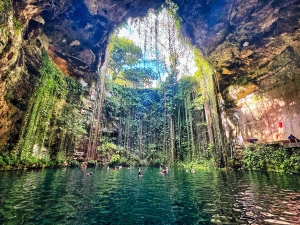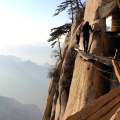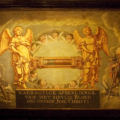Located in the Yucatán Peninsula, Chichén Itzá was one of the most influential cities of the ancient Maya world. Active from the Late Classic through the Early Postclassic period (c. 750 – 1200 CE), the site served not only as a political and economic center but also as a key destination for ritual movement and pilgrimage. Built in a karst landscape defined by underground rivers and sacred cenotes, Chichén Itzá emerged as a cosmological axis – where architecture, sacrifice, and myth converged.

A Sacred Name, A Sacred Well
The name Chichʼen Itzá translates as “At the mouth of the well of the Itzá,” referencing the nearby Sacred Cenote (Cenote Sagrado), a natural sinkhole used for ceremonial offerings. According to both archaeological data and post-Conquest sources, the Maya deposited precious objects – and, at times, human beings – into this cenote to petition the rain god Chaac. Excavations in the early 20th century recovered gold, jade, ceramics, incense, and skeletal remains bearing signs of sacrifice. The presence of elite and child remains suggests the cenote served as a destination for rites that involved prophecy, fertility, and renewal.
Unlike rivers or mountains, cenotes offered a unique intersection of cosmology and topography. Maya thought mapped the universe vertically: the heavens above, the earthly plane, and the watery underworld (Xibalba) below. Cenotes, therefore, were liminal spaces – thresholds to the divine – making them ideal destinations for ritual processions and ceremonial offerings.
Temples, Alignment, and Seasonal Pilgrimage
At the heart of Chichén Itzá stands the Temple of Kukulcán, also known as El Castillo, a four-sided pyramid rising 30 meters. Its architectural symbolism is tightly woven with cosmological principles. Each of the pyramid’s four sides has 91 steps, totaling 365 with the top platform—mirroring the solar year. During equinoxes, shadow and light cast along the northern stairway evoke the undulating body of a serpent descending toward earth—an allusion to Kukulcán, the feathered serpent deity associated with wind, rain, and celestial cycles.
These seasonal phenomena likely shaped ritual calendars and movement to the site, drawing visitors for agricultural ceremonies tied to sowing, harvest, and renewal. The ballcourts, tzompantli (skull racks), and processional causeways also speak to choreographed movement, guiding participants through a built landscape of sacred meaning.

Maya Deities and Cosmology
The Maya pantheon was deeply embedded in agricultural, meteorological, and cosmic rhythms. Major deities included:
- Chaac – the rain god, often invoked in times of drought or agricultural uncertainty.
- Kukulcán – a feathered serpent deity linked to fertility, wind, and the cycles of Venus; similar but not identical to the Aztec Quetzalcoatl.
- Itzamna – a creator god associated with writing and the sky.
- Ix Chel – a goddess of fertility, childbirth, and weaving.
Unlike the Aztec pantheon, which emphasized cyclical cosmic destruction and human sacrifice as central to sustaining the universe, the Maya view incorporated ritual sacrifice but placed greater emphasis on calendrical cycles, celestial observation, and intercession through elite ritual specialists. Both cultures engaged in offerings and bloodletting, but the contexts and cosmological frameworks were distinct.
Contrasts with the Aztec Worldview
Although Chichén Itzá displays some Toltec architectural influence – evident in warrior columns and jaguar-eagle motifs – it remains fundamentally Maya in worldview and ritual logic. Where the Aztecs centered their capital, Tenochtitlan, around military conquest and human sacrifice to the sun god Huitzilopochtli, Chichén Itzá’s ritual economy was tied more closely to agricultural fertility, cenote offerings, and planetary cycles—especially Venus.
Architecture like the Caracol, a circular observatory aligned to Venus’s movement, reveals the Maya’s advanced astronomical knowledge and its integration into temple construction, ritual timing, and civic organization.

Pilgrimage After the Collapse
Even after its political decline in the 12th century, Chichén Itzá retained spiritual significance. Post-Conquest accounts describe continued Maya visits to the Sacred Cenote for offerings, and Spanish conquistadors encountered active populations in the area. Oral tradition, combined with enduring landscape features like cenotes, helped preserve the site as a ritual destination long after the elite abandoned it.
The Cave of Balankanché, located a few kilometers from the main complex, further affirms the longevity of ritual pilgrimage. Here, artifacts and offerings remained undisturbed into modern times, testifying to sustained ceremonial use from the Preclassic era into the post-Conquest period.
Chichén Itzá functioned not only as a seat of power but as a ritual landscape designed for movement, observance, and offering. Through its sacred geometry, celestial alignments, and cenote-based rites, the city drew people across the northern Yucatán for generations. As a pilgrimage site, it occupied a space where cosmology was embedded in stone, sacrifice was a medium of negotiation with divine forces, and landscape was a map of mythic time. Though often compared to the Aztec ritual centers, Chichén Itzá reflects a distinct Maya worldview—one that emphasized water, cycles, and celestial harmony over conquest and apocalyptic cosmology.





